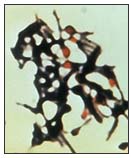Tetanus pathophysiology
|
Tetanus Microchapters |
|
Diagnosis |
|---|
|
Treatment |
|
Case Studies |
|
Tetanus pathophysiology On the Web |
|
American Roentgen Ray Society Images of Tetanus pathophysiology |
|
Risk calculators and risk factors for Tetanus pathophysiology |
Editor-In-Chief: C. Michael Gibson, M.S., M.D. [1]; Associate Editor(s)-in-Chief: Usama Talib, BSc, MD [2]
Overview
The bacteria that causes tetanus, Clostridium tetani, is usually introduced into the human body by direct inoculation of an open wound. The toxins produced by the bacterium, utilize the blood and/or lymphatics to gain access to target tissues. The toxins can act at various places in the central nervous system including the spinal cord, peripheral motor end plates, and the brain. Toxins can also act on the sympathetic nervous system.[1][2]
Pathophysiology
Tetanus is caused by an exotoxin from Clostridium tetani that leads to acute and often fatal illness. Generalized, widespread rigidity and skeletal muscle spasms are common presentations of tetanus. The muscle stiffness begins from the jaw (lockjaw) progressing to the neck and then becomes generalized. C. tetani is a terminal spore forming bacteria. The spores are resistant to extremes of temperature and to the normally used antiseptics. The spores can be found in the soil as well as in the intestines and feces of cattle, dogs, sheep, horses, cats, guinea pigs, rats, and chickens. Soil that has been treated with manure may contain a large quantity of spores. Human adults who work in agriculture may also harbor the pathogen.[3]
Pathogenesis
The pathogenesis of tetanus is as follows:[1][2][4][5][6][7][8]
- C. tetani gains access to the human body through a wound contaminated with the organism or through an umbilical stump (in cases of neonatal tetanus) by contact with contaminated medical tools.
- The spores germinate in the wound because of their anaerobic character.
- Toxins are produced and spread through the blood and lymphatics.
- C. tetani produces two exotoxins
- Tetanolysin,the function, of which, is not well understood
- Tetanospasmin, a metalloprotease, which is a neurotoxin responsible for the spasticity associated with tetanus. Tetanospasmin is among the most potent toxins known to man.
- The minimum lethal dose of tetanospasmin for humans is around 2.5 nanograms per kg of body weight or 175 nanograms for an individual who weighs 70-kg (154lb).
- The toxin uses retrograde transport along the nerve axon to reach the spinal cord and the brainstem.
- The toxins binds irreversibly with the receptors.
- The tetanus toxin cleaves the membrane proteins (SNARE proteins) that are responsible for expulsion of inhibitory neurotransmitters at the neuronal synapses.
- The disinhibition of upper motor neurons affects the lower motor neurons responsible for carrying motor cortex excitatory impulses affecting the autonomic neurons and the anterior horn cells.
- The disinhibition involving anterior horn cells leads to an unopposed contraction of the muscles, leading to excessive tone and muscular spasm which can be painful.
- The autonomic nervous system when disinhibited can lead to seizures.
- Neonatal tetanus develops within hours due to the shorter length of the axons.
Genetics
The role of genetics in the development of tetanus has not been well established. It is, however, believed that the formation of tetanus toxin is induced by the depletion of amino acids.[9]
Microscopic Pathology

References
- ↑ 1.0 1.1 Farrar JJ, Yen LM, Cook T, Fairweather N, Binh N, Parry J; et al. (2000). "Tetanus". J Neurol Neurosurg Psychiatry. 69 (3): 292–301. PMC 1737078. PMID 10945801.
- ↑ 2.0 2.1 Lalli G, Gschmeissner S, Schiavo G (2003). "Myosin Va and microtubule-based motors are required for fast axonal retrograde transport of tetanus toxin in motor neurons". J Cell Sci. 116 (Pt 22): 4639–50. doi:10.1242/jcs.00727. PMID 14576357.
- ↑ Del Pilar Morales E, Bertrán Pasarell J, Cardona Rodriguez Z, Almodovar Mercado JC, Figueroa Navarro A (2014). "Cephalic tetanus following penetrating eye trauma: a case report". Bol Asoc Med P R. 106 (2): 25–9. PMID 25065047.
- ↑ Rummel A, Bade S, Alves J, Bigalke H, Binz T (2003). "Two carbohydrate binding sites in the H(CC)-domain of tetanus neurotoxin are required for toxicity". J Mol Biol. 326 (3): 835–47. PMID 12581644.
- ↑ Schiavo G, Benfenati F, Poulain B, Rossetto O, Polverino de Laureto P, DasGupta BR; et al. (1992). "Tetanus and botulinum-B neurotoxins block neurotransmitter release by proteolytic cleavage of synaptobrevin". Nature. 359 (6398): 832–5. doi:10.1038/359832a0. PMID 1331807.
- ↑ Caccin P, Rossetto O, Rigoni M, Johnson E, Schiavo G, Montecucco C (2003). "VAMP/synaptobrevin cleavage by tetanus and botulinum neurotoxins is strongly enhanced by acidic liposomes". FEBS Lett. 542 (1–3): 132–6. PMID 12729912.
- ↑ Martha H. Roper, Jos H. Vandelaer & Francois L. Gasse (2007). "Maternal and neonatal tetanus". Lancet (London, England). 370 (9603): 1947–1959. doi:10.1016/S0140-6736(07)61261-6. PMID 17854885. Unknown parameter
|month=ignored (help) - ↑ Martha H. Roper, Jos H. Vandelaer & Francois L. Gasse (2007). "Maternal and neonatal tetanus". Lancet (London, England). 370 (9603): 1947–1959. doi:10.1016/S0140-6736(07)61261-6. PMID 17854885. Unknown parameter
|month=ignored (help) - ↑ Licona-Cassani C, Steen JA, Zaragoza NE, Moonen G, Moutafis G, Hodson MP; et al. (2016). "Tetanus toxin production is triggered by the transition from amino acid consumption to peptides". Anaerobe. 41: 113–124. doi:10.1016/j.anaerobe.2016.07.006. PMID 27492724.